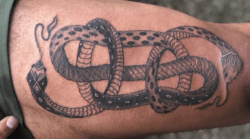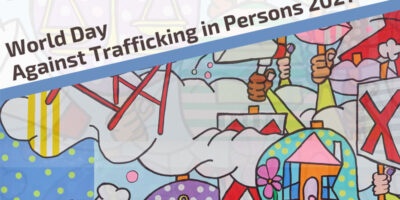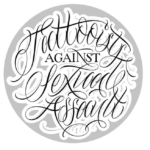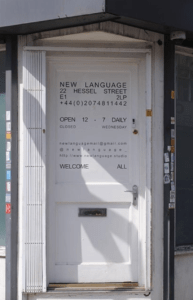The tattoo industry is having its own #MeToo movement
“Everyone else was turning a blind eye to this. If no one is going to do anything about this, then I am.” Lucy Pigeon, an artist working in Surrey, England, told me how the curtains are finally being pulled on systemic racism and sexism within the daily practices of the tattoo industry.
Dominated by the “outcast” white, cis man, the industry is now being challenged by tattooists all over the world, like Lucy, who want to fight the lack of regulation and the systemic power imbalances that lead to abusive behaviour within studios. The world of tattooing is having its own #MeToo movement, and we should all be paying attention.
Sexual Violence within the Tattoo Industry
The current activism that is taking place within the tattoo community is largely happening online. Lucy, who has been a tattoo artist for more than eight years, founded the Instagram account Tattooists Sexual Assault Survivor Support (TSASS) in March 2020 to respond to the growing problem of sexual abuse within the tattoo community. Lucy created the page so that people could anonymously share their experiences of abuse within the industry.
“The thought process behind it was to give people a platform to access help if they needed it and to have a discussion about what’s going on,” Lucy told me over Zoom. “Speaking to other women, it was clear that there was a need for a platform, a place that people could go for support, because a lot of people had the same or similar experiences and just didn’t know where to go.”
In May, a couple of offenders in the tattoo industry had been publicly outed, and this is when Lucy decided to go public with her experience of abuse in the industry. “It ended up going viral, getting near to 70,000 views. I mentioned the page in the video, and after that there was this huge influx of people that said they had a similar experience. It seems like a niche thing but in the first week I had close to four hundred messages.”
The Fight Against Systemic Racism
While this was unfolding, conversations about power imbalances within the industry stretched further to include systemic racism. Following the murders of George Floyd, Breonna Taylor and other Black Americans at the hands of the police, discussions surrounding the racism that occurs within studios were brought to the forefront.
Celebrity tattooists like Grace Neutral, popular for her documentary series ‘Beyond Beauty’ on i-D, temporarily gave her Instagram over to Black tattooists, like Montana Blue and Rizza Boo, to address the racism within the tattoo industry. In an Instagram Live hosted on Neutral’s page, Rizza Boo talks about their project called the Shades Tattoo Initiative, which is a “safe space to build community, educate artists, help build skills and showcase the work of Black and POC tattoo artists working in the UK.”
New York artist Doreen Garner also called for people to protect the Black tattoo community on their Instagram page. In a call-to-action post, Garner wrote, “In addition to supporting black tattooers, I ask that you also take the time to make public a racist tattoo artist.” Garner implored their followers to call out artists who “refuse to tattoo black people under any circumstance… and if they tell black people tattoos don’t look good on their skin.”
Under the posts, the comments were flooded with accounts of racism within the industry and specific call-outs to studios.
Tattooing has gained extreme popularity over the past decade, largely in part to artists promoting their work on social media platforms, like Instagram. While the numbers of BIPOC (Black, Indigenous, and People of Colour), Queer, and women tattoo artists have increased, the systemic issues of racism and sexism are still very much at play. Black and brown clients are turned away at the door and led to believe that their skin is not suited for tattoos and clients are left feeling taken advantage of by their tattoo artist.
Jess T. Fang, a New Jersey born tattoo artist in Brooklyn, told me about how the history of tattooing in the West has been built around colonization.
“Tattooing originated from our cultures, BIPOC cultures,” she said. “Tattooing has become an American tradition but in reality, most of it has originated from things like paintings from Southeast Asia that colonizers saw on their travels.”
Jess links the present systemic discrimination against BIPOC people to colonizers stealing art and designs from BIPOC cultures. “Even the word ‘tattoo’ comes from a Tahitian word tatau,” Jess said. “Everything down to the last detail is taken.”
The Inner Workings of the Industry
Implementing laws to mitigate racist and sexist acts within studios is very difficult, since the tattoo industry has no stable professional association and lacks regulation and accountability.
“The tattoo industry feels like it’s protected in its own little bubble and exempt from the rules that govern every other kind of business,” Lucy said. “It’s an inside clique – what happens inside the system stays inside the system and you can’t speak out against it.”
Rosa, a 32-year-old transmasculine non-binary New York based tattoo artist from Brazil told me about the struggles that transgender clients endure. “You are vulnerable when you are getting tattooed. The tattooer has a lot of control on what is going on – they are touching your body, telling you how to sit and that you are going to feel pain.”
Rosa tattoos a lot of trans folks, and told me, “Tattoos are very important to them to reconnect them to their own body, to recreate a relationship with parts of their body.” When artists do not ask for consent or have a discussion with their client prior to giving a tattoo, this experience can be very frightening.
Moving Towards Inclusivity and Safe Spaces
There is progress being made by brave artists in the tattoo industry to mitigate these negative experiences. Lucy told me how she is part of a group that is pushing forward a petition to make sure that tattoo artists are background checked before being hired. “In this country (the UK), you don’t need any kind of formal background check to be a tattoo artist. If you are getting tattooed, you are in a vulnerable position. You have the right to know that whoever is touching your body isn’t going to abuse that.”
Lucy and artist friends have formed a group that they have named The Milieu Tattoo Union. “Our focus is towards inclusivity, equality, and consent. We’ve done discussions about sexual abuse, but also the BLM movement and transgender and non-binary movements. Those aspects of the tattoo industry that aren’t talked about – we want to get those conversations going.”
Lucy wants this movement to have lasting effects. “We are at the point where we are talking about how to make this sustainable, so it doesn’t just fizzle out. I am really hopeful that this has made enough of an impact to be permanent.” In terms of her own future, she will continue running her tattoo studio, Autonomy Tattoo, and now has a counselling qualification so that she can best help survivors of sexual abuse.
There are many new tattoo studios that are popping up with a mandate of inclusiveness and equity. Morgan Myers, a Philadelphia-born, London-based tattoo artist opened New Language studio two years ago as a contemporary tattoo studio that also acts as a hub for art and publishing. The studio has a mandate of being a safe space, with “Welcome All” printed in plain ink on its front door.
“It is about welcoming all people into the space, that is the most important thing,” Morgan told me. “I focus on consent. When you touch somebody’s body, it is important to have a dialogue beforehand.” Morgan hopes that New Language can become a sort of contemporary gallery, with BIPOC tattooers coming in to take over the space of tattooing.
Welcome Home in Brooklyn, where Rosa works, is committed to long-term accountability and puts anti-racism, anti-sexism, anti-homophobia, and anti-transphobia at the centre of its practice. “It is a very strong community. It is a place where people feel welcome. Tattoos can reconnect people, especially trans people, to their own body, and Welcome Home is a space to make that possible.”
Rosa told me about how artists at Welcome Home will perform colour tests for folks with Black and Brown skin so that people can see how the colour shows on their skin, to mitigate the common stereotype that colour won’t show up on Black and Brown skin.
Saved Tattoo, was also located in Brooklyn, and had community and diversity at its core, Jess told me. Jess worked at Saved Tattoo before it had to close due to various factors, including the pandemic. “It was refreshing to be surrounded by people who are active in creating change,” Jess says.
Saved Tattoo had a focus on acknowledging the difference between appropriation and appreciation, respecting that these designs and tattoos are inspired by people who are not a part of the elite tattooing sphere. “Bringing the information and the focus back to Indigenous land and tattoo practices is the most important, because that is where they originated from.”
Jess says that Saved Tattoo led a charge in hiring more BIPOC and Queer artists and it was a goal to give more of the spotlight to these tattooers. “We still have so much work to do, but it is definitely starting up.”
Lucy, Rosa, Morgan, and Jess all agree that more education and awareness need to be brought to the issues in the tattoo industry. It is more important than ever for artists and studios to educate themselves and be committed to equality within their workspace. The act of getting a tattoo can be a very personal and intimate experience.
Rosa talks about getting a tattoo as “an exchange, not just a service,” an experience that both the artist and the client can enter into and be a “space of healing,” “It is our space, a space we create together.”
You can find the work of the artists mentioned in this article at the following links:
Lucy Pidgeon: https://www.instagram.com/lucytattoo/?hl=en
Jess T. Fang: https://www.instagram.com/jesstfang/?hl=en
Rosa Laura: https://www.instagram.com/rosalaura_/?hl=en
Morgan Myers: https://www.instagram.com/mymorg/?hl=en







